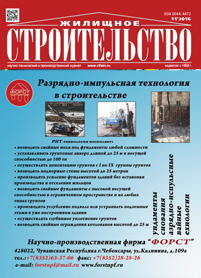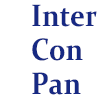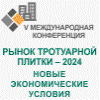Zhilishchnoe Stroitel'stvo №11

November, 2016
THE CONTRACT ON TRANSFER OF THE RIGHT FOR THE PUBLICATION (THE LICENSE CONTRACT) TO DOWNLOAD HERE (without the completed and signed license contract article for consideration and the publication won't be accepted)
Table of contents
Z.G. TER-MARTIROSYAN1, Doctor of Sciences (Engineering), V.V. SIDOROV1, Candidate of Sciences (Engineering), A.Z. TER-MARTIROSYAN1, Candidate of Sciences (Engineering) (gis-mgsu@mail.ru); A.V. MANUKYAN2, Doctor of Sciences (Engineering)
1 National Research Moscow State University of Civil Engineering (26, Yaroslavskoye Highway, 129337, Moscow, Russian Federation)
2 OOO «Concern MonArch» (31A, Leningradsky Avenue, 125284, Moscow, Russian Federation) Speed of Settlement of a Pile Submerged in the Depth of Clay Soil with Due Regard for Its Visco-Elastic and Visco-Plastic Properties
In the course of loading of long piles introduced in the depth of clay soils, it is necessary to predict the speed of their settlement in time. It can be fading, continuous and can develop with permanent speed depending on visco-plastic and visco-elastic properties of surrounding and underlying soils. This article presents the formulation and analytical solution of the problem of interaction of a rigid long pile with the surrounding clay soil and relatively dense soil underlying the pile toe bulb. The visco-elastic model of Bengam-Shvedov-Maslov is used as a calculation model for surrounding soil with due regard for its strengthening (softening) as well as the visco-plastic model of Timoshenko regarding the soil medium. A new visco-elastic model of soil in which the value of imposed shearing deformation is adopted as a parameter of strengthening is analyzed in details. Examples of the description of maim rheological curves- creep, relaxation, and kinematic shift – are presented. It is shown that visco-elastic and visco-plastic properties of surrounding soil significantly influence on the speed of pile settlement. The strengthening of the clay soil proportionally to the time leads to a damping of the speed of the pile settlement proportionally to the time logarithm. Accounting of visco-plastic properties of surrounding soil leads to reducing the radius of the pile influence before and, consequently, to reducing the speed of settling and the value of pile settlement. Keywords: creep, relaxation, kinematic shift, pile, settlement speed. References
1. Vjalov S.S. Reologicheskie osnovy mehaniki gruntov [Rheological basics of soil mechanics]. Moscow: Vysshaja shkola. 1978. 447 p. (In Russian).
2. Goldstein M.N. Mechanical properties of soil [Mechanical properties of soil]. Moscow: Stroyizdat, 1979. 302 p. (In Russian).
3. Zaretsky Yu.K. Viscoplasticity of soil and calculations of constructions [Viscoplasticity of soil and calculations of constructions]. Moscow: Stroyizdat, 1988. 246 p. (In Russian).
4. Maslov N.N. Osnovy inzhenernoi teorii i mekhaniki gruntov [Bases of the engineering theory and mechanics of soil]. Moscow: Vysshaya shkola, 1982. 511 p. (In Russian).
5. Rzhanitsyn A.R. Teoriya polzuchesti [Theory of creep]. Moscow: Stroyizdat, 1968. 415 p. (In Russian).
6. Telichenko V.I., Ter-Martirosyan Z.G. Interaction of a pile of big length with not linearly deformable massif of soil. Vestnik MGSU. 2012. No. 4, рр. 22–27. (In Russian).
7. Тer-Martirosyan Z.G. Mekhanika gruntov [Mekhanik of soil]. Moscow: ASV, 2009. 550 p. (In Russian).
8. Tymoshenko S.P. Gudyer Dzh. [Theory of elasticity]. Moscow: Nauka, 1975. 576 p. (In Russian).
9. Ter-Martirosyan Z.G. Reologicheskie parametry gruntov i raschet osnovanii sooruzhenii [Rheological parameters of soil and calculation of the bases of constructions]. Moscow: Stroyizdat, 1990. 200 р. (In Russian).
10. Ukhov S.B. Mekhanika gruntov, osnovaniya i fundamenta [Mechanics of soil, basis and base]. Moscow: Vysshaya shkola, 2007. 561 p. (In Russian).
11. Ter-Martirosjan Z.G., Ter-Martirosjan A.Z., Sidorov V.V. Initial critical pressure under the heel of the round foundation and bored piles under the heel of round section. Estestvennye i tehnicheskie nauki. 2014. No. 11–12 (78), pp. 372–376. (In Russian).
12. Ter-Martirosjan Z.G. Stress-strain state in a ground massif and its interaction with the pile and deep foundations. Vestnik MGSU. 2006. No. 1, pp. 38–49. (In Russian).
13. Ter-Martirosyan Z.G., Ter-Martirosyan A.Z., Malek A. The Intense deformed condition of the two-layer basis with the transformed top layer. Vestnik MGSU. 2008. No. 2, pp. 81–95. (In Russian).
A.O. KUZNETSOV, Engineer-programmer (kuzemon91@mail.ru) Siberian Transport University (191, D. Kovalchuk Street, 630049, Novosibirsk, Russian Federation) Determination of Parameters of Limit Equilibrium of a Soil Body at Interaction with a Reinforcing Member by Analytical and Numerical Methods
The solution of the problem of determining the qualitative type and the value of limiting pressure of absolutely smooth horizontal reinforcing elements on the reinforced sliding wedge of failure along the slide lines corresponding to the Culmann’s scheme is considered. The solution of problem was made by two methods: analytical according to the theory of limit equilibrium of soils, and numerical according to the finite elements method. According to the theory of limit equilibrium of soils, a rigorous solution of determination of the limit pressure presented by the classical trinomial formula of Terzaghi has been obtained. According to the finite elements method, the developed solution with corresponding comments and recommendations is presented. On the basis of calculation results, the qualitative type of formation of the limiting loading, its chief dimensions and numerical value of the limit pressure are compared; conclusions and recommendation on the use of each of the methods considered for determining the limit pressure are made. Keywords: nagel, horizontal reinforcement of soil body, Culmann’s scheme, theory of limit equilibrium of sois, finite elements method. References
1. Oreste P.P., Dias D. Stabilisation of the Excavation Face in Shallow Tunnels Using Fibreglass Dowels. Rock Mech. Eng. 2012. Vol. 45. No. 4, pp. 499–517.
2. Savel’ev Yu.N. Nails in the construction tunnel of underground in Novosibirsk. Cand. Diss. (Engineering). Novosibirsk. 2002. 155 p. (In Russian).
3. Patent RF 2485318. Sposob stroitel’stva stantsionnykh tonnelei s malymi osadkami zemnoi poverkhnosti [The method of construction of the stations tunnels with low downfall the earth’s surface]. Bezrodnyi K.P., Markov V.A., Maslak V.A., Morozov A.V., Salan A.I., Starkov A.Yu., Ukhanov A.V., Protosenya A.G., Lodus E.V. Declared 25.01.2012. Published 20.06.2013. Bulletin No. 17. (In Russian).
4. Frolov Yu.S., Ivanes T.V., Kavkazskii V.N., Kon’kov A.N. Solution of geotechnical problems in the construction of transport tunnels in the Olympic Sochi. Transport Rossiiskoi Federatsii. 2013. No. 6, pp. 12–18. (In Russian).
5. Lunardi P. Design and Construction of Tunnels. Leipzig, Germany. 2008. 575 p.
6. Lunardi P., Andrea B., Roslyakova M., Dzenti. K.L. Strengthening excavation and slaughter kernel using A.DE. CO-RS method. Metro i tonneli. 2011. No. 4, pp. 26–29. (In Russian)
7. Korolev K.V. The bearing capacity of foundations in stabilized and not stabilized. Doct. Diss. (Engineering). Novosibirsk. 2014. 326 p. (In Russian).
8. Ulitsky V.M., Shashkin A.G., Shashkin K.G., Shashkin V.A. Osnovy sovmestnykh raschetov zdanii i sooruzhenii. [Basics of joint calculations of buildings and structures] Saint- Petersburg: Georekonstruktsiya. 2014. 328 p.
О.S. GLOSMAN, Candidate of Sciences (Engineering), Adviser, RAACS (7457915@gmail.com) Russian Academy of Architecture and Construction Sciences. (24, bldg. 1, B. Dmitrovka Street, 107031, Moscow, Russian Federation) Underground Planning of Moscow
It describes the innovative practice of inclusion of functional zoning of underground space in the document of territorial planning of the Russian city. The list and the description of 41 zones of multipurpose underground space of the city of Moscow is provided. Three multipurpose zones of various type are given as an example. Keywords: urban planning, geo-urbanistics, underground space, master plan, public spaces. References
1. Semenova O.S. Methodology of project arrangement zones in multifunctional public spaces as a part of the transportation system under land use of underground spaces in major cities. Gradostroitelstvo. 2014. No. 2 (30), рр. 62–68. (In Russian).
2. Semenova O.S., Mordvin A.S. The concept of integrated development of underground space on an example of territory near the Sokolniki metro station in Moscow. Engineering and technologies of the XXI century. 2016. Рр. 89–95. (In Russian).
3. Semenova O.S. Architectural methods of preventing social conflicts on the urbanized territories. International research journal. 2016. No. 5 (47), рр. 120–125. (In Russian).
4. Shustov I.N. Harmonization of legislation is the basis of the urban development of underground space of the builtup urban territories. 15th World conference of Associated Research Centers for the Urban Underground Space. ACUUS 2016. 439 р. (In Russian).
N.S. SOKOLOV, Candidate of Sciences (Engineering), Director (forstnpf@mail.ru), S.N. SOKOLOV, Engineer, Deputy Director for Science, A.N. SOKOLOV, Engineer, Deputy Director for Production (forstnpf@mail.ru), OOO NPF «FORST» (109a, Kalinina Street, 428000, Cheboksary, Chuvash Republic, Russian Federation) About Wrong Method for Arrangement of Bored-Injection Piles with the Use of Electric Discharge Technology
The article presents an episode from the practice of geotechnical construction when the deviations from the technological cycle when arranging bored-injection EDT-piles could lead to the detrimental consequence. In the course of construction of the multistory building of the hotel in the city of Nizhny Novgorod, a technological error was made. The execution of a separate stage of the technological sequence “well boring – concreting – electro-hydraulic treatment – reinforcement” was carried out by a certain contractor organization. As a result, different stages of producing EDT-piles were executed by different contractor organizations and there was no possibility to control stage-by-stage the concrete strength development. That’s why over 50% of produced EDT-piles didn’t reach the design bearing capacity. As a result, there was an acute necessity to redesign the whole pile field with inclusion of additional EDT-piles with multiple broadenings due to which the designed bearing capacity of pile-slab foundations of the building as a whole has been provided. Keywords: bored-injection pile, electric-discharge technology (EDT), multiple broadenings, monolithic reinforced concrete buttresses, pile bearing capacity, fine concrete strength. References
1. Patent RF 2282936. Generator impul’snykh tokov [Generator of pulse currents]. N.S. Sokolov, Yu.P. Pichugin. Declared 4.02.2005. Published 27.08. 2006. Bulletin No. 24. (In Russian).
2. Patent RF 2250958. Ustroistvo dlya izgotovleniya nabivnoi svai [The device for production of a stuffed pile]. N.S. Sokolov, V.Yu. Tavrin, V.A. Abramushkin. Declared 14.07.2003. Published 27.04. 2005. Bulletin No. 12. (In Russian).
3. Russian Federation patent for plezny model No. 161650. Ustroistvo dlya kamufletnogo ushireniya nabivnoi konstruktsii v grunte [The device for camouflage broadening of a stuffed design in soil]. N.S. Sokolov, H.A. Dzhantimirov, M.V. Kuzmin, S.N. Sokolov, A.N. Sokolov. Declared 16.03.2015. Published 27.04.2016. Bulletin No. 2. (In Russian).
4. Sokolov N.S., Ryabinov V.M. About one method of calculation of the bearing capability the buroinjektsi-onnykh svay-ERT. Osnovaniya, fundamenty i mekhanika gruntov. 2015. No. 1, pp. 10–13. (In Russian).
5. Sokolov N.S., Ryabinov V. M. About efficiency of the device the buroinjektsionnykh of piles with multi-seater broadenings with use of electro-digit technology. Geotechnica. 2016. No. 2, pp. 28–32. (In Russian).
6. Sokolov N.S., Petrov M.V., Ivanov V.A. Calculation problems the buroinjektsionnykh of the piles made with use of digit and pulse technology. Materials of the 8th All-Russian (the 2nd International) the «New in Architecture, Designing of Construction Designs and Reconstruction» conference (NASKR-2014). 2014. Cheboksary, pp. 415–420. (In Russian).
7. Sokolov N.S. Metod of calculation of the bearing capability the buroinjektsionnykh svay-RIT taking into account «thrust bearings». Materials of the 8th All-Russian (the 2nd International) the «New in Architecture, Designing of Construction Designs and Reconstruction» conference (NASKR-2014). 2014. Cheboksary, pp. 407–411. (In Russian).
8. Sokolov N.S., Viktorov S.S., Fedorov T.G. Piles of the raised bearing capability. Materials of the 8th All-Russian (the 2nd International) the «New in Architecture, Designing of Construction Designs and Reconstruction» conference (NASKR-2014). 2014. Cheboksary, pp. 411–415. (In Russian).
9. Sokolov N.S., Petrov M.V., Ivanov V.A. Case of restoration of an emergency historical and cultural monument of federal importance to Cheboksary. Materials of the 8th All- Russian (the 2nd International) the «New in Architecture, Designing of Construction Designs and Reconstruction» conference (NASKR-2014). 2014. Cheboksary, pp. 328–335. (In Russian).
10. Sokolov N.S., Ryabinov V.M. Features of the device and calculation the buroinjektsionnykh of piles with manyplaced broadenings. Geotechnica. 2016. No. 3, pp. 4–8. (In Russian).
11. Sokolov N.S., Sokolov S.N., Sokolov A.N. Experience of recovery of a dangerous structure of the Vvedensky cathedral to Cheboksary. Geotechnica. 2016. No. 1, pp. 60–65. (In Russian).
12. Sokolov N.S., Ryabinov V.M. Technique of Construction of Bored-Injection Piles of Increased Bearing Capacity Zhilishchnoe Stroitel’stvo [Housing Construction]. 2016. No. 9, pp. 30–32. (In Russian).
13. Sokolov N.S. Technological Methods of Installation of Bored- Injection Piles with Multiple Enlargements. Zhilishchnoe Stroitel’stvo [Housing Construction]. 2016. No. 10, pp. 54–57. (In Russian).
O.S. SUBBOTIN, Doctor of Architecture (subbos@yandex.ru) Kuban State Agrarian University (13, Kalinina Street, 350044, Krasnodar, Russian Federation) Innovative Materials and Technologies in Public Buildings of Sochi
The article is devoted to innovative materials and technologies used when designing and constructing public buildings in the city of Sochi. Such objects of urban values as the railway station in Adler, the main media center in the Olympic Park are considered. Their technical-economic parameters, architectural-planning and structural solutions are indicated. A special place in the study occupies widespread certified products and constructions of company KNAUF, engineering systems REHAU which made it possible to significantly contribute to the development of energy-efficient construction. The importance of the use of innovative materials for the restoration, reconstruction and major repairs of monuments of architectural and urban heritage is highlighted. BIM-technologies, a new phenomenon in the world design and construction industry, are of considerable interest. Special attention is paid to modern engineering systems based on innovative scientific and technological achievements. Keywords: innovation, technology, material, construction, railway station, media center, composition, panel, partition. References
1. Nasledie REHAU [Heritage REHAU]. Moscow: Magistral, 2015. 200 p. (In Russian).
2. Subbotin O.S. Regional features of the architecture of railway complexes. Zhilishnoe Stroitelstvo [Housing construction]. 2013. No. 1, pp. 18–21. (In Russian).
3. Yumasheva E.I. The German industrialists in Russia: historical analogies and continuity of traditions. Stroitelnye Materialy [Construction materials]. 2015. No. 5, pp. 44. (In Russian).
4. Yumasheva E.I. The Russian plaster branch reached the European technological level and qualities. Stroitelnye Materialy [Construction materials]. 2014. No. 11, pp. 36. (In Russian).
5. Subbotin O.S. Innovative materials in Kuban monuments of urban architectural heritage. Zhilishnoe Stroitelstvo [Housing construction]. 2015. No. 11, pp. 35–40. (In Russian).
6. Airapetov G.A. Stroitelnye Materialy [Construction Materials]. Rostov na Donu: Phoenix, 2009. 699 p. (In Russian).
7. Ferronscaya A.V. Gipsovye materialy i izdeliya (proizvodstvo i primenenie) [Gypsum materials and products (production and use)]. Moscow: ASV, 2004. 488 p. (In Russian).
8. Talapov V.V. Building Information Modeling – modern understanding. CADmaster. 2010. No. 4 (54), pp. 114–121. (In Russian).
9. Subbotin O.S. The architecture of intelligent low-rise residential buildings. Vistnik MGSU. 2010. No. 3, pp. 6–9. (In Russian).
M.K. ISHCHUK1, Laboratory Head, Candidate of Sciences (Engineering) (kamkon@ya.ru), O.K. GOGUA1, Leading Researcher, Candidate of Sciences (Engineering), D.A. ALEKHIN1, D. Sh. FAYZOV1, Engineers; V.N. NIKOLAEV2, Deputy General Director, E.A. LITVINOV2, Deputy General director; A.A. POPOV3, Director
1 TSNIISK named after V.A. KUCHERENKO, Research Center “Construction” (6, 2nd Institutskaya Street, 109428, Moscow, Russian Federation)
2 OOO “GALEN” (52, Karl Marx Street, Cheboksary, 428000, Chuvash Republic, Russian Federation)
3 Ceramic Material Manufacturers Association (2a, Shchelkovskoe Shosse, 105122, Moscow, Russian Federation) Fire Resistance of Non-Bearing External Walls with Face Layer of Brick Masonry with Flexible Basalt-Plastic Bracings
Results of the fire test of fragments of external non-bearing three-layer walls with sizes of 3.33.3(h) m with a face layer of brick masonry connected with a thin non-bearing layer by flexible basalt-plastic bracings “GALEN” are presented. Bracings of two types were used: rods with sand tips and meshes. The wall internal layer was made of the masonry of ceramic brick of 12 cm thickness and cellular-concrete blocks of 10 cm thickness. The space between layers was filled with mineral wool plates of 15 cm thickness. From the face layer side there was an air gap of 3 cm thickness. The test results show that under the fire impact of 45 min duration, the limit state E regarding the loss of integrity and I regarding the loss of thermal insulation capacity in both samples were not reached, thus the fire resistance corresponds to EI 45 grade at maximally established fire resistance for non-bearing walls – E 30. Keywords: three layer non-bearing external walls, brick facing, flexible basalt-plastic bracings, internal layer of wall, ceramic brick masonry, masonry of cellular concrete blocks, fire testing, fire resistance, cracks in masonry.
A.V. MASLYAEV, Candidate of Sciences (Engineering) (victor3705@mail.ru) Volgograd State University of Architecture and Civil Engineering (1, Akademicheskaya Street, 400074, Volgograd, Russian Federation) Analysis of the Compliance of RF Federal Laws and Normative Documents of Building Contents with Requirements of the RF Constitution
Even non-specialists know about the supremacy of the RF Constitution over the other RF Federal Laws. That’s why, in the course of development of RF Federal Laws and normative documents, especially for dangerous building industry, it is necessary to strictly comply with the requirements of the RF Constitution. The world statistics about catastrophic consequences under the impact of dangerous natural phenomena testifies that in most cases the main reason for people’s death was the absence of provisions concerning the protection of human health and life in buildings and structures in many countries. The article lists the Federal Laws and main normative documents of the Russian Federation, in which the requirements of the RF Constitution for protection of human health and life in buildings at earthquakes are not fulfilled. It is proposed to examine the RF Federal Laws and normative documents concerning the construction for their correspondence to the articles 2, 4, 72 of the RF Constitution. Keywords: earthquake, seismic impact, seismic protection, building, human life. References
1. Masljaev A.V. Analys of positions of federal laws and standard documents of the Russian Federation on application of cards of seismic danger (ОSR-2015) in building. Zhilishchnoe stroitel’stvo [Housing construction]. 2016. No. 8, рр. 3–8. (In Russian).
2. Masljaev A.V. Analys of a paradigm of the joint venture 14. 13330.2014 on maintenance of seismoprotection of buildings of the raised responsibility at earthquake. Zhilishchnoe stroitel’stvo [Housing construction]. 2015. No. 8, рр. 51–55. (In Russian).
3. Masljaev A.V. Preservation of health of the people who are in buildings at earthquake. Natural and technogenic risks. Safety of construction. 2014. No. 2, рр. 38–42. (In Russian).
4. Koff G.L., Ryumina E.V. Seismic risk (Kinds, an estimation, management). Moscow: Polteks, 2003. 108 р.
5. Masljaev A.V. Seismic stability Buildings taking into account repeated strong pushes at earthquake. Zhilishchnoe stroitel’stvo [Housing construction]. 2007. No. 10, рр. 20–21. (In Russian).
6. Masljaev A.V. Calculation of buildings and constructions for preservation of life and health of people at earthquake. Zhilishchnoe stroitel’stvo [Housing construction]. 2009. No. 8, рр. 33–35. (In Russian).
7. Masljaev A.V. Maximum permissibl a damage rate in buildings and constructions of the raised responsibility while in service before earthquake. Vestnik VolgGASU. Building and architecture. 2012. No. 29 (48), рр. 80–85. (In Russian).
8. Masljaev A.V. Analys of federal state educational standards of higher education in a direction of preparation «Building». Zhilishchnoe stroitel’stvo [Housing construction]. 2015. No. 12, рр. 21–25. (In Russian).
A.A. TITUNIN, Doctor of Sciences (Engineering), K.V. ZAITSEVA, Candidate of Science (Engineering) (kseniya_zaiceva@mail.ru) Kostroma State Technological University (17, Dzerzhinskogo Street, 156005, Kostroma, Russian Federation) Wood Scientific and Technological Problems Productions of Glued Materials for Wooden Housing Construction
Steady demand for low houses from wood, including from a glued bar, is feature of the present stage of housing construction. A row the wood scientific and technological problems exists and they define quality of construction materials and houses. As properties of wood vary depending on wood breed, the area of growth, humidity and other factors, they need to be considered at all production phases of details for construction. Features of a macrostructure of wood, in particular width of year layers, the sizes and quantity of knots define quality indicators of ready details for housing construction. It is noted that the interrelation of strength properties and existence of knots in wood is confirmed with researches of domestic and foreign authors. Results of long-term researches of the module of elasticity of timber of the coniferous breeds growing in various regions of Russia are presented in article. It is established that visual sorting of the timber used for production of a glued bar isn’t always justified. Machine sorting according to durability is preferable because allows to exclude rejection of timber because of the big sizes and quantity of knots. Keywords: wooden housing construction, glued bar, production of details, sorting. References
1. Development of wooden housing construction // LesPromInform. 2015. No. 2 (108), pp. 136–139. (In Russian).
2. Kazejkin V.S., Baronin S.A., Chernyh A.G., Androsov A.N. Problemnye aspekty razvitija malojetazhnogo zhilishhnogo stroitel’stva Rossii [Problem aspects of development of low housing construction of Russia]: monografija / pod obshhej redakciej Akademika MAIN V.S. Kazejkina i prof. S.A. Baronina. Moscow: INFRA-M. 2011. 278 p.
3. New impulse of wooden housing construction. Lesnaja industrija. 2015. No. 4 (84). http://www.lesindustry.ru/issues/ li_n84/ (data of access 11.10.2015). (In Russian).
4. Titunin A.A. Zajceva K.V. Proektirovanie i proizvodstvo stroitel’nyh materialov iz drevesiny. Kompleksnyj podhod [Design and production of construction materials from wood. Integrated approach]: monografija / otv. red. A.M. Ibragimov. Kostroma: Izd-vo KGTU. 2009. 185 p.
5. Titunin A.A. Resursosberezhenie v derevoobrabatyvajushhej promyshlennosti. Organizacionno-tehnicheskie aspekty [Resource-saving in the woodworking industry. Organizational and technical aspects]: monografija. Kostroma: Izd-vo KGTU. 2007. 141 p.
6. Ashkenazi E.K., Ganov Je.V. Anizotropija konstrukcionnyh materialov [Anisotropy of constructional materials]: spravochnik. Moscow: Mashinostroenie. 1980. 375 p.
7. Hruljov V.M. Prochnost’ kleevyh soedinenij [Durability of glue connections]. Moscow: Strojizdat. 1973. 84 p.
8. Hruljov V.M., Titunin A.A., Ibatulin R.R. Realization of effects of additivity and sinergizm in designs from composite materials for wooden housing construction. Konstrukcii iz kompozicionnyh materialov: mezhotraslevoj nauch.-teh. zhurnal RAN. Moscow. 2004. No. 2. pp. 10–12. (In Russian).
9. Titunin A.A. Pilot studies of durability of wooden glued beams. Stroitel’nyj jekspert. M.: NTObumdrevprom. 2003. No. 18, p. 10. (In Russian).
10. Volynskij V.N., Plastinin S.N. Pervichnaja obrabotka pilomaterialov na lesopil’nyh predprijatijah [Preprocessing of timber at the sawing enterprises]: Uchebnoe posobie. 2-e izd., ispr. Saint-Petersburg: Lan’. 2012. 264 p.
11. Borovikov A.M., Ugolev B.N. Spravochnik po drevesine [Reference book on wood]. Moscow: Lesnaja promyshlennost’. 1989. 296 p.
12. Borovikov A.M., Habarova G.P. About visual sorting of bars according to durability. Lesnoj zhurnal. 1982. No. 1. (In Russian).
13. Cucera W. Hoizfehler und ihr Einfluss auf die technische Eigenschaften der Fichte und Kiefer. Hoiztechnologie. 1970. No. 4, pp. 210–216.
S.А. SYCHEV, Candidate of Sciences (Engineering) (sasychev@ya.ru) Saint-Petersburg State University of Architecture and Civil Engineering (4, 2-ya Krasnoarmeyskaya Street, 190005, Saint-Petersburg, Russian Federation) Automated System for High-Speed Erection of Buildings from Modules and Modular Systems
The most time-consuming stage in the process of erecting building constructions is the process of pre-installation and verification of building structures. The automated control system of technological process provides automated collection and processing of information necessary to optimize the management of the object in accordance with the adopted criteria, and implementation of control actions on the process of construction of buildings of modular systems. The control object is a combination of technological equipment and the technological process of modules installation implemented on its base according to appropriate algorithms and regulations. System, built-in blocks for direct interaction with the operator, must contain lasers with emission wavelength in the visible range. In this case, optimal conditions for analyzing the current state of installation are provided and the minimization of the nomenclature of the used equipment of the measuring and information system is carried out. Keywords: quick assembly, unified modular constructions, prefabricated in the factory, prefabricated modular buildings, high speed of construction. References
1. Asaul A.N., Kazakov Ju.N., Bykov B.L., Knjaz’ I.P., Erofeev P.Ju. Teorija i praktika ispol’zovanija bystrovozvodimyh zdanij [The theory and practice of use of the fastbuilt buildings]. Saint-Petersburg: Gumanistika, 2004. 463 р. (In Russian).
2. Afanas’ev A.A. Tehnologija vozvedenija polnosbornyh zdanij [Technology of construction of prefabrication buildings]. Moskva: ASV, 2000. 287 р. (In Russian).
3. Sychev S.A. System analysis technology of high-speed construction in Russia and abroad. Perspektivy nauki. 2015. No. 9, pp. 45–53. (In Russian).
4. Afanas’ev A.V., Afanas’ev V.A. Organizacija stroitel’stva bystrovozvodimyh zdanij i sooruzhenij. Bystrovozvodimye i mobil’nye zdanija i sooruzhenija: perspektivy ispol’zovanija v sovremennyh uslovijah [The organization of construction of the fast-built buildings and constructions. The fast-built and mobile buildings and constructions: prospects of use in modern conditions]. Saint-Petersburg: Strojizdat, 1998, рр. 226–230. (In Russian).
5. Verstov V.V., Badyin G.M. Features of design and construction of buildings and constructions in St. Petersburg. Vestnik gragdanskih ingenerov. 2010. No. 1, рр. 96–105. (In Russian).
6. Nikolaev S.V. SPKD – system of construction of housing for future generations. Zhilishchnoe Stroitelstvo [Housing construction]. 2013. No. 1, pp. 7–15. (In Russian).
7. Sychev S.A. Modelirovanie tekhnologicheskikh protsessov uskorennogo montazha zdanii iz modul’nykh sistem. Montazhnye i special’nye raboty v stroitel’stve. 2015. No. 11, pp. 18–25. (In Russian).
8. Day A. When modern buildings are built offsite. Building engineer. 2010. No. 86 (6), pp. 18–19.
9. Allen E., Iano J. Fundamentals of building construction: Materials and methods. J. Wiley & Sons. 2004, 28 p.
10. Fudge J., Brown S. Prefabricated modular concrete construction. Building engineer. 2011. No. 86 (6), pp. 20–21.
11. Staib G., Dörrhöfer A., Rosenthal M. Components and systems: Modular construction: Design, structure, new technologies. Institut für internationale Architektur-Dokumentation, München, 2008. 34 p.
12. Knaack U., Chung-Klatte Sh., Hasselbach R. Prefabricated systems: Principles of construction. De Gruyter. 2012. 67 p.
 |
 |
 |
 |
 |
 |
 |
